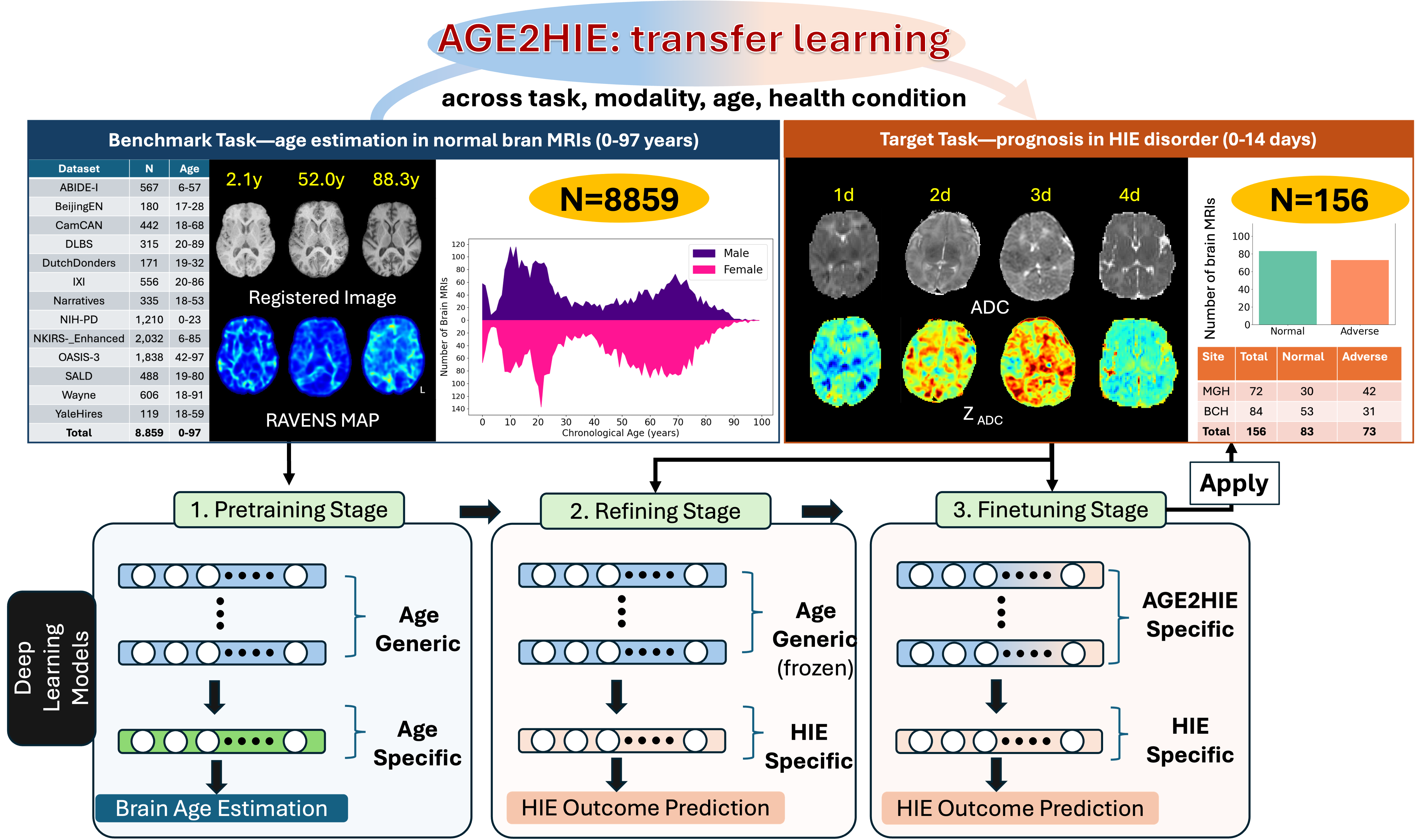Neonatal General 4: Novel Technology and Therapies
Session: Neonatal General 4: Novel Technology and Therapies
809 - AGE2HIE: Transfer Learning from Brain Age to Predicting Neurocognitive Outcome for Infant Brain Injury
Friday, April 25, 2025
5:30pm - 7:45pm HST
Publication Number: 809.3950
rina bao, Boston Children's Hospital, Boston, MA, United States; Sheng He, Harvard Medical School, Boston, MA, United States; Patricia Ellen. Grant, Boston Children's Hospital, Boston, MA, United States; Yangming Ou, Boston Children's Hospital, Boston, MA, United States

Rina Bao, PhD (she/her/hers)
Postdoctoral Research Fellow
Boston Children's Hospital
Boston, Massachusetts, United States
Presenting Author(s)
Background: Hypoxic-Ischemic Encephalopathy (HIE) affects 1 to 5 out of every 1,000 newborns, with 30% to 50% of cases resulting in adverse neurocognitive outcomes. However, these outcomes can only be reliably assessed as early as age 2. Therefore, early and accurate prediction of HIE-related neurocognitive outcomes using deep learning models is critical for improving clinical decision-making, guiding treatment decisions and assessing novel therapies. However, a major challenge in developing deep learning models for this purpose is the scarcity of large, annotated HIE datasets.
Objective: We have assembled the first and largest public dataset, however it contains only 156 cases with 2-year neurocognitive outcome labels. In contrast, we have collected 8,859 normal brain Magnetic Resonance Imagings (MRIs) with 0-97 years of age that are available for brain age estimation using deep learning models. In this study, we aim to develop a method to transfer knowledge learned by deep learning models from brain age estimation to HIE outcome prediction.
Design/Methods: We propose AGE2HIE to transfer knowledge from healthy controls brain MRIs to a diseased cohort, from structural to diffusion MRIs, from regression of continuous age estimation to prediction of binary neurocognitive outcomes, and from lifespan age (0-97 years) to infant (0-2 weeks). AGE2HIE framework includes two main parts (three stages, as shown in Fig. 1): pre-training the deep learning model (Pretraining stage) for brain age estimation (benchmark task) and transferring the pre-trained deep learning model (Refining Stage and Finetuning Stage) for HIE outcome prediction (target task).
Results: Compared to training from scratch, transfer learning from brain age estimation significantly improves not only the prediction accuracy (3% or 2% improvement in same or multi-site, shown in Table 1), but also the model generalization across different sites (5\% improvement in cross-site validation, shown in Table 2).
Conclusion(s): In this paper, we introduced AGE2HIE, a novel transfer learning approach that leverages knowledge learned by deep learning models from brain age estimation task to HIE outcome prediction. We evaluated the proposed AGE2HIE on BONBID-HIE datasets with 156 subjects. Our experimental results show the advantages of transfer learning for brain age estimation to HIE outcome prediction with small samples. The proposed AGE2HIE consistently boosts the performance of deep learning models for both accuracy and generality, effectively addressing the limitations of the small HIE dataset.
Figure 1. AGE2HIE framework.
 The framework of the proposed AGE2HIE for transferring knowledge learned by deep learning models from brain age estimation (benchmark task, left-upper pannel, with exmaple images and data distribution) with 8,859 samples to HIE outcome prediction (target task, right-upper pannel, with exmaple images and data distribution) with only 156 subjects. The bottom row shows the three stages of transfer learning: 1, Pretraining Stage trains all layers of the model which contains the age generic layers (blue color) and age specific layer (green color); 2, Refining Stage replace the age specific layer to HIE specific layer (orange color) and only trains this HIE specific layer, and 3, Finetuning Stage fine-tunes all layers of the deep learning model to learn the AGE2HIE Specific layers which contains age generic and HIE specific information.
The framework of the proposed AGE2HIE for transferring knowledge learned by deep learning models from brain age estimation (benchmark task, left-upper pannel, with exmaple images and data distribution) with 8,859 samples to HIE outcome prediction (target task, right-upper pannel, with exmaple images and data distribution) with only 156 subjects. The bottom row shows the three stages of transfer learning: 1, Pretraining Stage trains all layers of the model which contains the age generic layers (blue color) and age specific layer (green color); 2, Refining Stage replace the age specific layer to HIE specific layer (orange color) and only trains this HIE specific layer, and 3, Finetuning Stage fine-tunes all layers of the deep learning model to learn the AGE2HIE Specific layers which contains age generic and HIE specific information.Table 1.
 Accuracy without vs with transferring age-pretrained model to HIE outcome prediction.
Accuracy without vs with transferring age-pretrained model to HIE outcome prediction.Table 2.
 Generality without vs with transferring age-pretrained model to HIE outcome prediction.
Generality without vs with transferring age-pretrained model to HIE outcome prediction.
